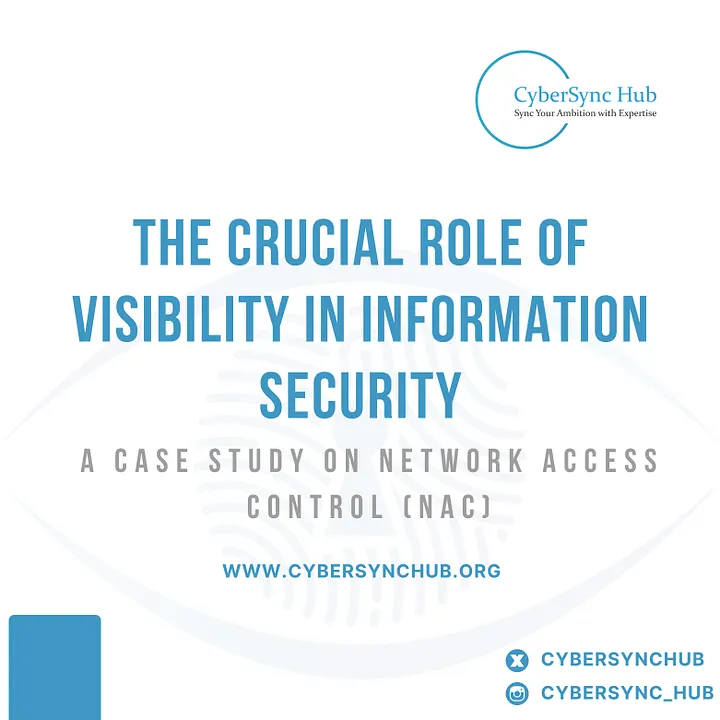Maintaining robust security is more challenging than ever as cyber threats grow increasingly sophisticated, targeting the core of our digital infrastructure. Amidst these challenges, one principle has emerged as indispensable for effective protection: visibility. This article explores the importance of visibility in Information security, focusing on Network Access Control (NAC) as a case study.
The Importance of visibility in Information security.
Visibility refers to the ability to see and understand the activities occurring within a network. It encompasses the monitoring and analysis of data flows, user activities, and system interactions. Without comprehensive
visibility, Information security teams are essentially operating in the dark, unable to detect anomalies, prevent breaches, or respond effectively to incidents.
- Early Threat Detection: Visibility allows for the early detection of potential threats. By monitoring network traffic and user behavior, Information security teams can identify unusual activities that may indicate a security breach. Early detection is crucial for mitigating damage and preventing widespread compromise.
- Enhanced Compliance: Regulatory compliance is a significant concern for many organizations. Visibility ensures that all activities are tracked and logged, facilitating compliance with standards such as GDPR, HIPAA, and PCI-DSS. It provides the necessary audit trails to demonstrate adherence to these regulations.
- Effective Incident Response: In the event of a security incident, visibility is critical for effective response. It allows Information security teams to quickly identify the source and scope of the breach, implement containment measures, and initiate remediation efforts. Without visibility, response efforts are hampered by a lack of crucial information.
What is Network Access Control (NAC)?
Network Access Control (NAC) is a security solution that enforces policies for network access, ensuring that only authorized users and devices can connect to and operate within an organization’s network. NAC solutions work by authenticating devices before they connect, assessing their security posture, and granting or restricting access based on compliance with predefined policies.
NAC provides a powerful means of enhancing network security, particularly in environments where the proliferation of devices and remote work have expanded the attack surface.
Case Study — The Role of NAC in Visibility.
Consider a mid-sized financial institution that implemented NAC to enhance its network security. The institution faced challenges due to the growing number of devices connecting to its network, including employee laptops, personal mobile devices, and Internet of Things (IoT) gadgets. With each new connection, the potential for security risks increased, making it essential to have robust controls in place.
The Challenge — Lack of Visibility.
Before implementing NAC, the institution struggled with visibility. Information security teams could not see all the devices connecting to the network, making it difficult to enforce security policies or detect unauthorized access. This lack of visibility meant that the organization was vulnerable to threats such as rogue devices, unauthorized access, and data breaches.
The Solution — Implementing a NAC for Improved Visibility.
By implementing a NAC solution, the institution gained the visibility it desperately needed. The NAC system automatically identified and authenticated every device attempting to connect to the network. It also
assessed each device’s security posture, ensuring compliance with the institution’s security policies before granting access.
With NAC, the Information security team could monitor all network activities in real-time, identifying and responding to threats more quickly. Unauthorized devices were immediately blocked, and any suspicious
behaviour was flagged for further investigation. This improved visibility not only enhanced security but also provided valuable insights into network performance and usage.
The Outcome — Enhanced Security and Operational Efficiency.
The implementation of NAC transformed the institution’s approach to network security. With full visibility into the network, the Information security team could proactively manage and secure the environment. The
risk of data breaches was significantly reduced, and the institution was better equipped to meet regulatory compliance requirements.
Furthermore, the insights gained from NAC’s visibility allowed the institution to optimize network performance, ensuring that resources were allocated efficiently and that potential issues were addressed before they could impact operations.
Conclusion
Visibility is the cornerstone of effective Information security. As this case study on NAC demonstrates, without visibility, organizations cannot adequately protect their networks from the myriad of threats they
face today. By implementing solutions like NAC, organizations can achieve the visibility they need to monitor network activities, enforce security policies, and respond to incidents swiftly.
In a world where cyber threats are constantly evolving, investing in visibility through solutions like NAC is not just advisable but it’s essential.


